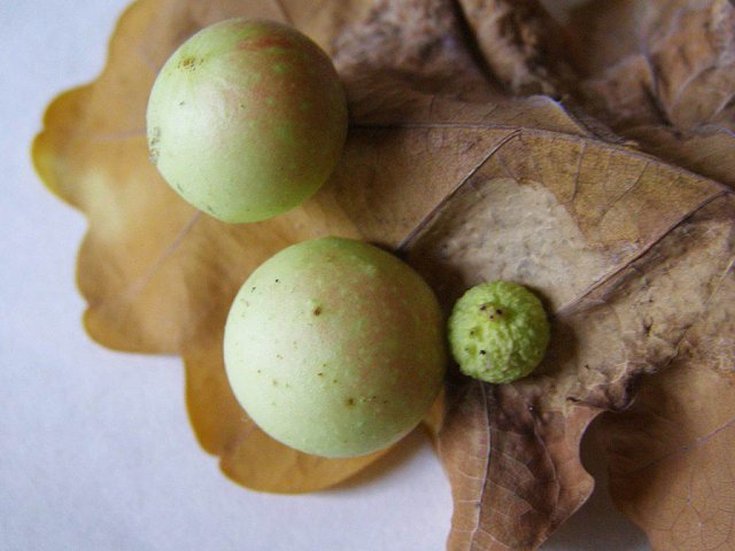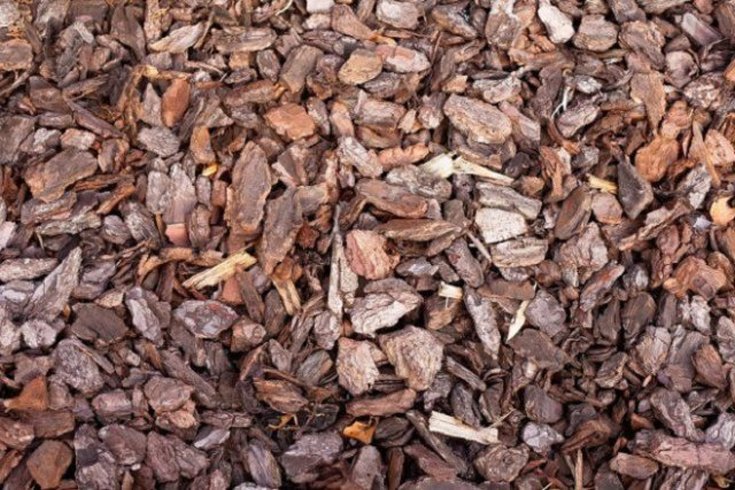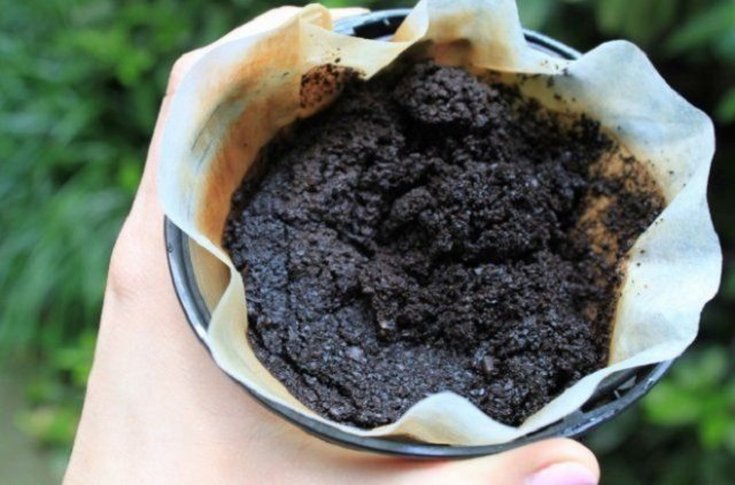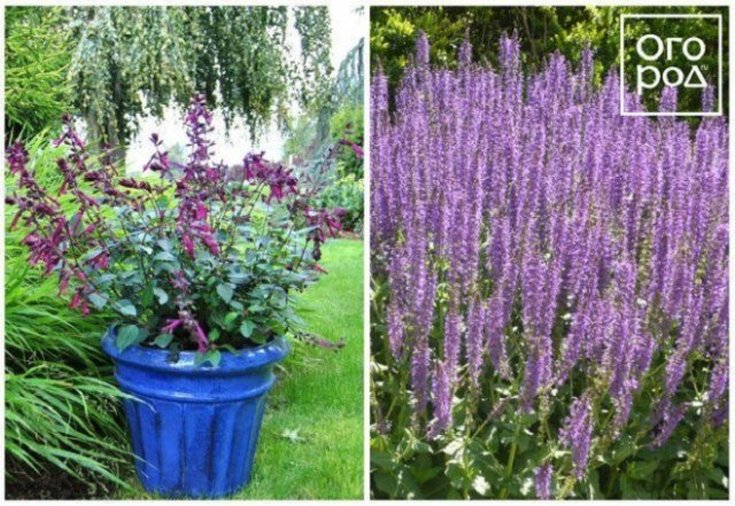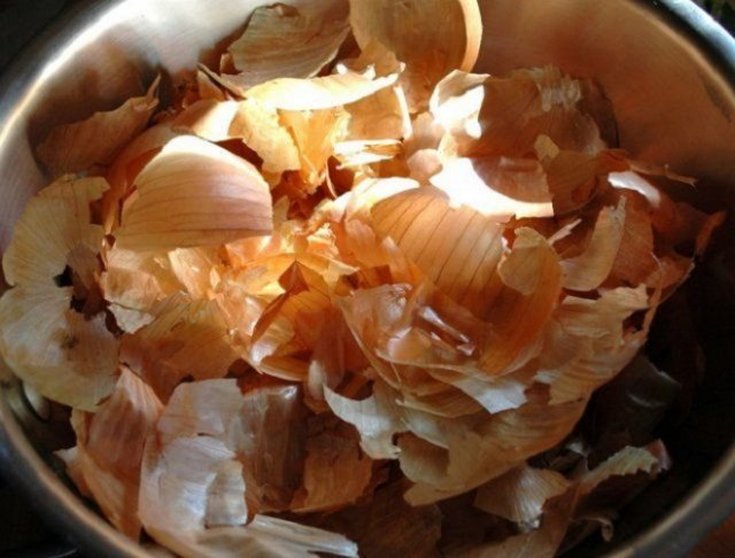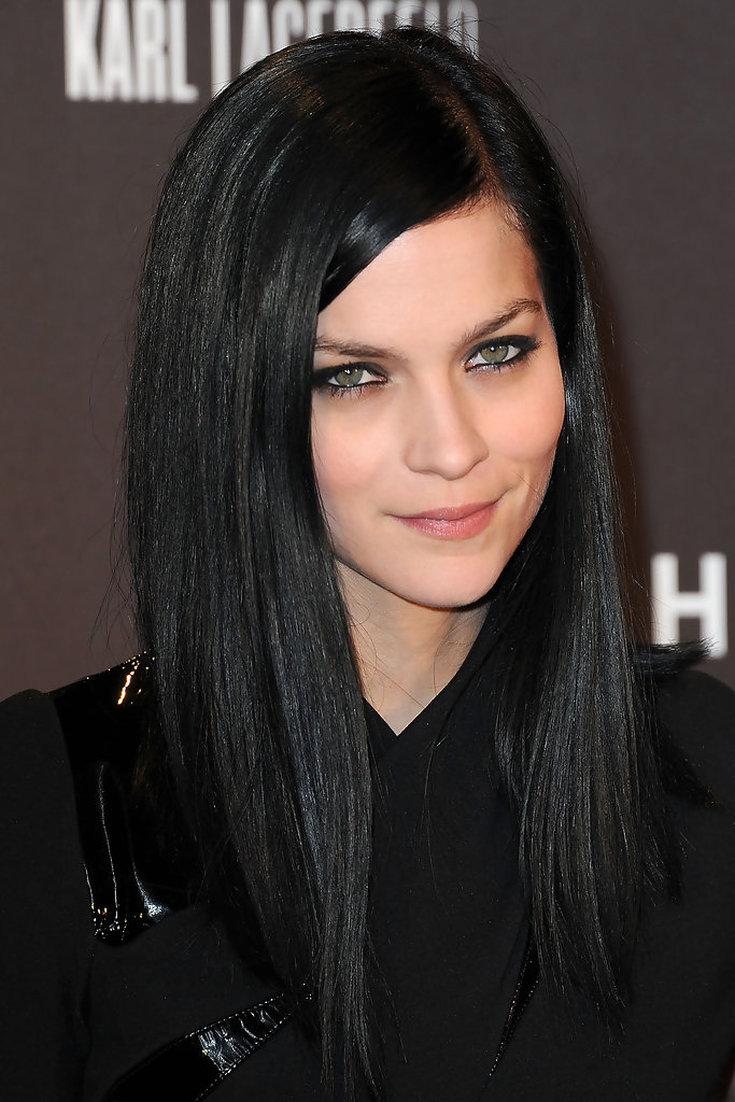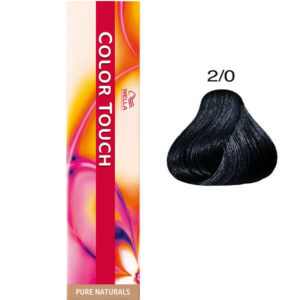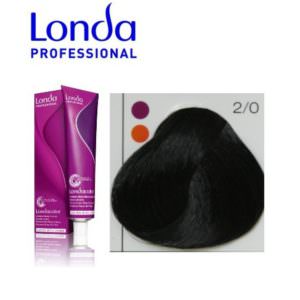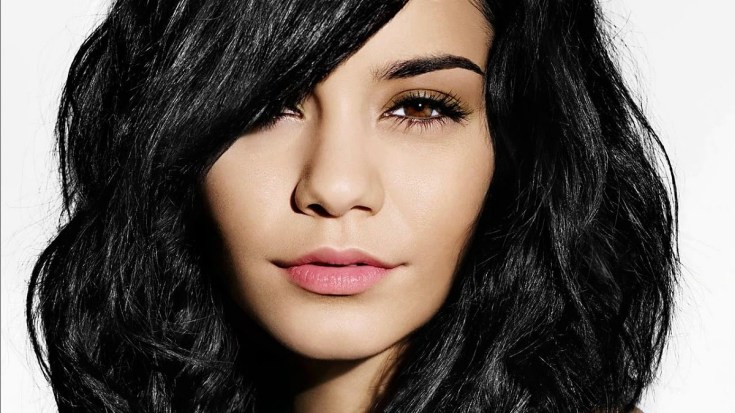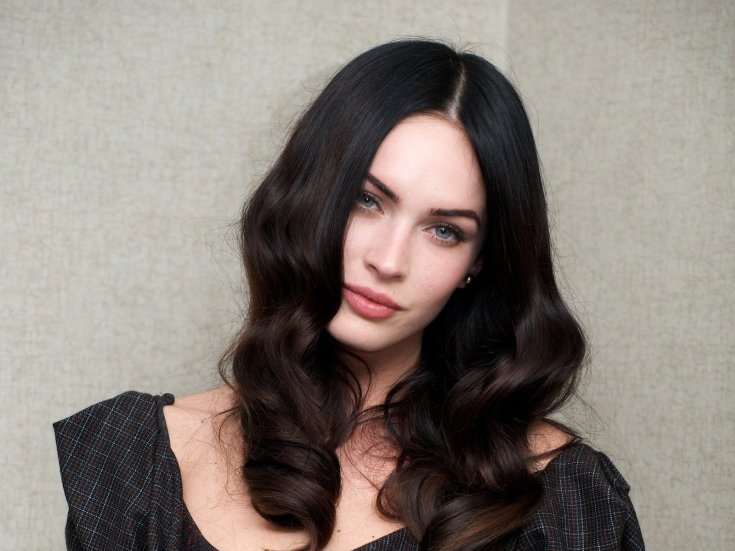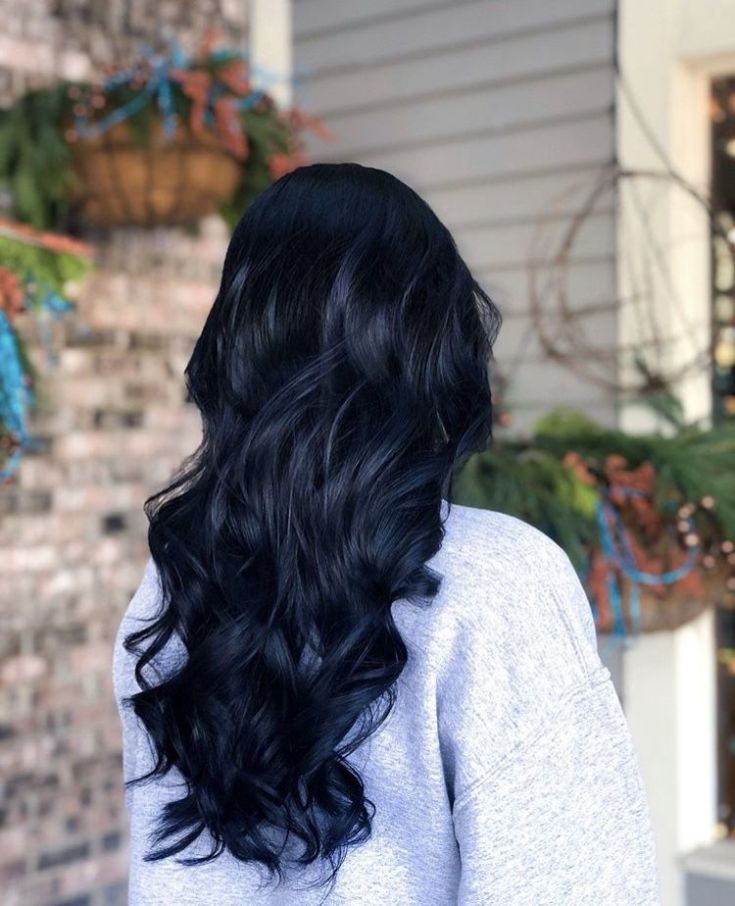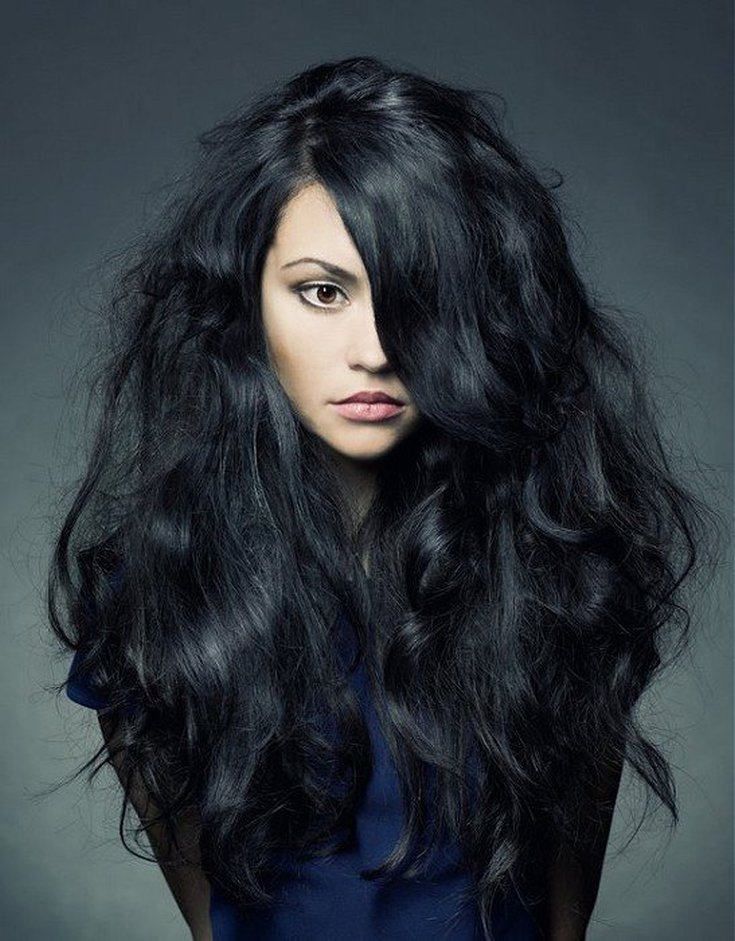- Change hair shade without dye
- How to prepare and use natural dyes at home
- Folk recipes for home hair coloring
- Henna and Basma
- Ink nuts
- Spruce and oak bark
- Walnut
- Ground coffee and black tea
- Sage
- Onion peel
- Black palette
- Staining rules
- Top best dyes for getting black hair
- Wella Professional Color Touch
- Loreal Professional Dia Richesse
- Londa professional
- Schwarzkopf Igora Vibrance
- Delight trionfo constant
- Coloring features
- Persistent paints
- Natural dyes
- Advantages and disadvantages
- How does black hair affect character?
- Tips and tricks for the selection of makeup
- Conclusion
A burning brunette 👩🏻 has always attracted, attracts and will attract the looks of men, 👀 after all, it is simply impossible not to pay attention to such an expressive hair color. But what about those whose natural color is some kind of faded and expressionless shade? ❓ Let's figure it out together!
Change hair shade without dye
And it is really possible to do it even at home - let's talk today about natural hair dyes.
How are natural hair dyes different from industrial ones? Not only the lack of beautiful bright packaging. They consist of components of natural origin that do not enter into a chemical reaction with the pigments of your hair, do not destroy or damage them, unlike synthetic dyes.
This is a real gentle ammonia-free dyeing - after all, you are aware that industrial harmless ammonia-free hair dyes do not exist, no matter what they tell you in commercials!
They have a minimum of contraindications (except that the individual intolerance of a particular component) - these paints can be used even during pregnancy. In addition, natural dyes can strengthen your hair and give it a beautiful shine, add moisture and nourishment to your hair, and normalize the work of the sebaceous glands. In addition, they are unusually cheap and available to absolutely everyone.
The relative disadvantages of natural dyes are that they:
- are not able to radically change the color of the hair, but only give it a lighter or darker shade;
- they are quickly washed off, so they will have to be painted more often than "chemical" ones;
- poorly suited for gray hair that is devoid of pigment;
- depending on the strength of the prepared dye solution, it is possible to "miss" the expected color.
How to prepare and use natural dyes at home
We will give specific recipes for the preparation of a particular dye below, mainly solutions and infusions.
The best results with this home color can be obtained on natural hair. If you are not sure of the result, you can carry out a trial preliminary coloring on some unobtrusive strand.
Be careful! If you have permed or dyed your hair with industrial dyes for many years in a row (that is, the structure of your hair is noticeably disturbed), then as a result of dyeing with natural dyes, you can get either a very unexpected shade or no result at all.
We recommend using these products on clean, just washed, damp hair. Apply them while wearing gloves, as it is more convenient - with a flat brush, strand by strand, or with a damp sponge.
For best results, you can cover your head with plastic and wrap it up with a towel for a couple of hours - this will improve blood circulation in the scalp and the paint will "set" better.
Of course, if your hair is long and thick, you will need more dye, and you will have to keep it longer. Otherwise, focus on the original hair color and the desired result.If you didn't get the desired saturation the first time, it doesn't matter. Natural “dyes” are good because, unlike store-bought ones, they do not harm the hair, and the procedure can be safely repeated the next day until the desired shade is obtained.
After the required exposure time, it is usually enough to rinse the hair with warm water without shampoo - all natural dyes are easily washed off (this does not apply to oil-based mixtures).
Folk recipes for home hair coloring
There are many simple and proven home remedies for dyeing your hair darker. Choose the one that's right for you. Remember that the more concentrated the infusion you make and the longer you keep it on your hair, the more intense the coloring will be - do not overdo it!
Henna and Basma
You can get a dark hair color at home, for example, with the help of well-known henna and basma - the most persistent natural dyes. Henna is the dried and crushed leaves of perennial lawsonia and alkanes. Basma - crushed indigo leaves (from the legume family). The tannins, which are found in abundance in these plants, are also responsible for the color there, and there.
Both henna and basma not only color the hair, but literally strengthen it and give it vitality.
Many professional hairdressers do not advise their clients to use these dyes if they do not intend to do this constantly, but want to return to chemical dyeing after a couple of treatment procedures. The fact is that henna and basma quite tightly "eat" into the hair and then prevent the penetration of other dyes into the interior.
Henna itself gives a reddish color, basma - dark to almost black. By mixing them in different proportions, you can achieve exactly the shade of brown that suits you. You need to be especially careful with these dyes after a perm or bleaching of hair - the resulting color may turn out to be overly bright, from acid-red to black-green.
To prepare coloring mixtures, first dry henna and basma powders are mixed in selected proportions, then they are diluted with hot water or room temperature kefir to the state of gruel.
If desired, you can add binding components to the mixture - glycerin or flaxseed decoction. A warm solution is distributed through the hair, covered with cellophane and wrapped in a towel. The principle is the same - the longer you hold the mixture, the darker and richer the color will turn out. At the end of the procedure, the hair is rinsed abundantly with warm water without shampoo.
The initial proportions of henna and basma powders for obtaining different shades are as follows:
- 1: 1 for an even chestnut color;
- 1 henna: 2 basmas for an almost black color;
- 2 henna: 1 basma for a bronze shade on a light chestnut base;
- 2 henna: 1.5 basma for a dark brown color.
Also, instead of basma, you can add heated red wine or cranberry juice to the henna powder (the color will turn out to be a little more cherry), dry tea or ground coffee (the shade will be calmer), crushed rhubarb leaves (the color will approach natural chestnut), dried buckthorn bark (for a dark chestnut shade).
Ink nuts
This name actually hides oak galls, which contain many tannins and tannins. It is the latter that are responsible for obtaining a dark, almost black color - once upon a time people made ink with the help of ink nuts since the time of the Roman Empire!
Today, we can easily use this remedy at home for dyeing hair in very dark shades. To do this, the powder from nuts must be ground with any oil until a homogeneous slurry is obtained, and then the mixture must be heated until the release of oily vapors stops.
The warm mass is applied to the hair under the film for a period of one to several hours, depending on the expected result.After the end of the exposure time, the head is washed with shampoo.
Spruce and oak bark
They are also very effective home dyes for those wishing to turn into a dark brown-haired or brunette without harming their hair.
Pour boiling water over the spruce or oak bark powder and keep under the lid for at least three hours. Then strain the composition and apply to the hair under cellophane. The exposure time is from 1 to 4 hours, depending on the desired degree of darkening of the curls.
Walnut
You can also achieve fairly rich browns by dyeing your hair with a walnut peel.
At maturity, its tree produces large fruits with a thick green skin. It is these green shells that we need for dyeing our hair, and not those dried kernels that we love to eat so much.
If you have ever picked these soft nuts, you will notice that their green peel even stains the skin of your hands. It is this property of the juice that we will use to obtain a beautiful chestnut color.
Moreover, this can be done in several ways at once:
- boil the chopped peel (with the addition of leaves) at the rate of 100 g per 1 liter of water for about 20 minutes. Cool the mixture, squeeze out and apply the resulting warm gruel to the hair for 20-40 minutes, depending on the desired shade;
- chopped peel in a 1: 1 ratio is mixed with alum, add a little vegetable oil and pour boiling water (in this recipe for 1.5 tablespoons peel, the same amount of alum is taken, half a glass of oil and a little less water). In a warm form, the mixture is applied to the hair for 20-40 minutes.
- The juice of the peel is mixed with alcohol at the rate of 2 tbsp. per 100 ml and the resulting infusion is abundantly moistened with hair. Wash off after 10-30 minutes.
Ground coffee and black tea
Yes, yes, these are not only beloved drinks by many, but also excellent means for toning your hair in darker shades. Remember only that your hair is just as demanding on the quality of the drink as you are - coffee for these recipes should be used only ground, and tea - leaf or granulated.
To achieve a beautiful dark shade without reddishness, you can simply regularly rinse your hair with strong brewed and pre-strained coffee or black tea, or you can resort to more drastic methods.
There are several options for preparing the dye mixture:
- 4 tsp Boil coffee for a few minutes, cool slightly and add a bag of henna. Stir the mixture and distribute warm through the hair, put on a plastic cap and stand for 10-40 minutes;
- 2 tbsp Boil black tea in 300 ml of water and add a bag of henna to the tea leaves. Apply a warm mixture to the hair along the entire length;
- 4 tsp brew tea tightly, strain and add the same amount of cocoa powder. Stir well and apply to hair;
- 1 tsp coffee dissolves in 2 tsp. warm water, then add 2 egg yolks to the mixture, 1 tbsp. cognac and 1 tsp. olive oil. The mixture is rubbed and applied to the hair.
All of the above mixtures are not only dyes, but also toning hair masks.
Sage
This medicinal plant can also be used to color brown hair - did you know? And all due to the fact that its shoots contain tannins that can give the solution a dark color.
- To make the “dye”, dried stems and leaves must be crushed and covered with boiling water at the rate of about 4 tablespoons. greens in a glass of water. Depending on how much you insist on the solution (from half an hour) and how much you keep it on your hair, you can get quite dark strands.
The solution should be washed off with plain warm water until it becomes colorless. If the resulting color seems to you insufficiently saturated, the procedure can be repeated without fear the very next day - there will be no harm to the hair.
Onion peel
This tool will help darken blondes and other beauties with a fairly light hair tone, and then provided that the solution is applied to the hair for a sufficiently long time.Otherwise, instead of the desired chestnut color, you will get a golden color.
For coloring, you need a sufficiently strong solution that can be used to treat hair for several days in a row. To obtain it, 150 g of onion husks are poured into 400 ml of water and boiled over low heat for at least 30-40 minutes. Add 2 tsp to a slightly cooled warm and strained mixture. glycerin and applied to hair for 40-60 minutes.
And these are not all the recipes on how to achieve a dark shade of hair at home! Resourceful young ladies also use hop cones, blackberry juice, young twigs and linden flowers, cocoa, nut leaves, even soy sauce for this purpose.
Black palette
For most men, it remains a mystery how ladies manage to distinguish one red lipstick from another and how there can be many shades in black. But the woman not only catches the difference, but also manages to wrap it up to her advantage. From modern manufacturers, in addition to the classic burning black, in the palettes you can also find:
- Bluish black, or the color of a raven wing, - deep tone with a pronounced bluish tint. Suitable for owners of gray and blue eyes, which lose their shine with ordinary black.
- Black Tulip - soft dark color with a reddish or burgundy tint. Very suitable for women with green and brown eyes. Suitable for owners of warm natural hair shades: red, wheat, chestnut.
- Plum black - trendy, but very insidious color with an eggplant tint. He mercilessly emphasizes all the disadvantages: pale or unhealthy skin, bruises and wrinkles, age. Only the youngest and bravest can afford it.
We would like to emphasize that fantasy tones also require a more careful selection of colors in wardrobe and cosmetics, since they are discordant with a large number of shades.
Staining rules
For naturally dark-haired beauties, the question of how to dye their hair black is not worth it. You just need to buy a good paint and follow the instructions. Indeed, in this case, the color does not change radically, and small errors will be almost invisible.
When using persistent paints, do not forget to protect your hands with gloves - the pigment stuck under the nails is washed out for a very long time and looks like ordinary dirt.
- Those who decide to apply black on very light, gray, colored and bleached hair will have to prepare them first. The following recommendations of specialists will be useful to them:
- Thin and severely damaged hair must first be treated - undergo at least a two-week course of nourishing and moisturizing masks.
- For those who have never dyed black before, it is better to choose natural paints or tonic - in a maximum of a month, in case of failure, there will be no trace of them.
- If henna was used for staining, it is advisable to apply persistent paints no earlier than two weeks later, otherwise the shade may be unpredictable.
- Although it seems that the hair turns black almost instantly, the exposure time must be observed, otherwise the pigment will wash off very quickly.
On unevenly colored hair (after highlighting, bronzing and other modern techniques) it is better not to experiment with black at home - there will not be an ideal color.
It is worth going to the salon even if you have chosen to dye your zebra hair in black and white. There, the result depends very much on the equal width and symmetrical arrangement of contrast stripes, and it is impossible to achieve this on your own at home.
Top best dyes for getting black hair
Wella Professional Color Touch
Contributes to obtaining a truly rich shade on the hair. The composition contains keratin and natural wax. The cost is 720 rubles.
Loreal Professional Dia Richesse
A product for weakened, damaged and exhausted hair that has undergone various procedures (perm, straightening, and so on). The cost is 680 rubles.
Londa professional
Using it, you can get a very close to natural color.The composition contains a complex of nutritional components. The cost is 271 rubles.
Schwarzkopf Igora Vibrance
The color will be uniform and stable. Professional series. The cost is 233 rubles.
Delight trionfo constant
One of the best budget-priced products. The cost is 120 rubles.
Coloring features
Depending on the natural shade, type and condition of the hair, you can use permanent and natural dyes or proven folk recipes to get black. Each of these tools has its own pros and cons, which should be considered when choosing.
Persistent paints
Perhaps their only advantage is that the shade lasts from 4 to 6 weeks, and even longer on dark hair. Although in the case of not too successful staining, this immediately becomes the main disadvantage.
Black color allows you to use a minimum percentage of oxidizing agent, which means that the hair will suffer less than when lightening.
But there are more than enough minuses.
Permanent paints:
- often provoke allergic reactions;
- strongly irritate the skin;
- paint the head black;
- lie unevenly on porous hair;
- dry and brittle curls;
- not recommended for pregnancy.
In addition, when self-dyeing, women often distribute them unevenly through the hair and unpainted strands are too noticeable. This problem can be partially solved with the help of a tonic, but often you have to turn to the masters for salvation.
It is best to try to choose professional ammonia-free paints. For example: "Casting Gloss" from "Loreal", "Oil Intense" from "Cess", "Color Shue" from "Niche" and others. In their composition, in addition to the coloring pigment, there are natural oils and substances that protect the cuticle from severe damage.
And although the price of such dyes is quite high, hair treatment will ultimately cost a lot more and cause a lot of hassle.
Natural dyes
The most popular natural dye for obtaining a black shade of hair is Basma. But in its pure form, it is rarely used, since in fact it is a dark blue plant pigment. Although for those who want to give natural black hair a bluish tint, it suits perfectly well.
The rest need to dilute basma with henna. The proportions may vary. Most often, you have to calculate your shade empirically. The principle is this - the more henna is added, the more the color goes into brown, since it is an orange-red pigment. Therefore, to obtain henna bitter chocolate, you need to add about a third, only to neutralize the blue.
It is impossible to achieve pure black with the help of basma. In addition, if applied incorrectly, the color may not turn out as expected at all. Here's how to paint with basma:
- rinse hair well with shampoo and remove excess moisture with a towel;
- Pour the powder into a non-metallic container (or both, if henna is added) and pour water with a temperature of 70-80 degrees;
- mix the composition and achieve a uniform consistency like liquid sour cream;
- apply it to the roots with a brush, and then distribute it as evenly as possible along the length;
- wrap your head with cellophane, wrap with a towel and stand for at least 30 minutes (you can up to 2 hours to strengthen the roots);
- rinse hair thoroughly with lukewarm water and rinse with a weak solution of apple cider vinegar or citric acid.
Henna and basma will last no more than 2-3 weeks on the hair. And with frequent washing, you will have to paint almost once every 7-10 days. On the other hand, such masks perfectly strengthen the roots, promote rapid growth and prevent hair loss.
Advantages and disadvantages
Pros:
- Spectacular bright appearance.
- By choosing the right shade, the result will definitely be great.
- The ability to use bright makeup.
Minuses:
- The shade is not suitable for everyone.
- Highlights all imperfections.
- It is very difficult to get out of it.
- The species is very spoiled by overgrown roots.
- Not suitable if you have dandruff.
How does black hair affect character?
Women with black hair are strong-willed, strong and calculating persons, often not thinking about the feelings of other people.
Their characteristic features: accuracy, freedom of action and willfulness. Looking at a black-haired lady, you involuntarily begin to think about passion, mystery and incredible elegance.
Brunettes are often very domineering and active ladies.
Tips and tricks for the selection of makeup
Women with dark skin and black hair can practically give up makeup, but white-skinned beauties need a bright make-up.
To add expressiveness to the eyes, experts advise:
- Use a dark eyeliner.
- Have shades of gold and bronze tones in your cosmetic bag.
- Use eyeshadow in cool shades (blue, pink, and so on).
The lips should look seductive and sexy. Take advantage of:
- bright lipstick;
- shades of pink;
Conclusion
According to the reviews of many women, you can get a really beautiful, rich black color only with the help of high-quality professional paints. Most products from the mass media segment quickly fade, wash out unevenly, and their brightness has to be maintained all the time with tint balms, which are also not very good for frequent use.









